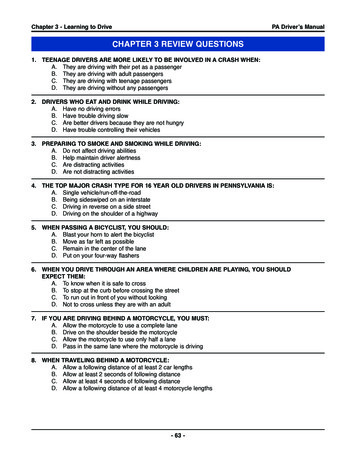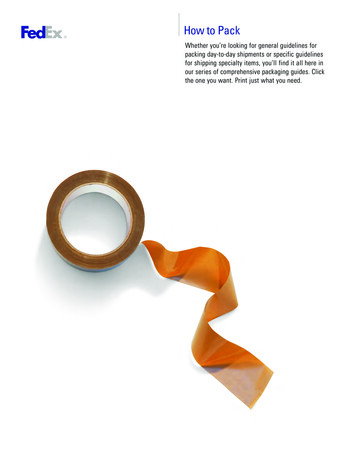
Transcription
Department ofVeterans AffairsJournal of Rehabilitation Research andDevelopment Vol . 34 No . 1, January 1997Pages 91-100CLINICAL REPORTInfluences of Cane Length on the Stability of Stroke PatientsChun-Liang Lu, MD ; Bing Yu, PhD ; Jeffrey R. Basford, MD ; Marjorie E . Johnson, MS, PT ; Kai-Nan An, PhDOrthopedic Biomechanics Laboratory, and the Department of Physical Medicine and Rehabilitation, Mayo Clinic andMayo Foundation, Rochester, MN 55905Abstract—The purpose of this study was to investigate theinfluence of cane length on the standing and walking stabilityof stroke patients . Ten stroke patients were used as subjects andevaluated by using two different cane lengths based on themeasurements of the distance from distal wrist crease to theground (WC cane), and the distance from greater trochanter toground (GT cane) . Force plates were used to determine the center of pressure (COP) . The maximum sways, the total traveldistances, and the mean travel speeds of the COP were analyzed for each patient standing and walking with and withoutcanes . It was found that the total travel distance and the meantravel speed of the COP in the medial-lateral (M-L) directionwere significantly lower when standing with a cane than whenstanding without one . It was also found that the values of theseparameters and the maximum sways of the COP in both anterior-posterior (A-P) and M-L directions were significantly lowerwhen standing with the WC cane than when standing with theGT cane . No significant difference was found in the maximumM-L sway, the total travel distance, and the mean travel speedof the COP in walking . These results suggest that the standingstability of stroke patients is improved by using canes, especially by using a WC cane, although no significant influence ofusing canes on the walking stability was detected . Based on theresults of this study, the vertical distance from the wrist creaseto ground is recommended as the appropriate cane length forstroke patients.INTRODUCTIONCerebrovascular accidents (CVAs) or strokes are acommon neurological problem in the United States . Theprevalence rate of strokes is approximately 5 percent forthose aged 65 and older (1), and rises with age . Peoplewho have suffered from a stroke frequently have poorcoordination, unilateral muscle weakness, decreasedstanding and walking stability, and impaired sensation(2) . One of the common consequences of these problemsis falling . It has been reported that the incidence of fallsis 14 percent in the acute setting (3), and 54 percent afterhospital discharge (4) . Poor stability is believed to be themajor cause of falls after strokes (5) . The standing andwalking stability of a stroke patient, either during admission or after discharge from a hospital, is thought to bethe most important predictor of ambulation ability (6).The standing and walking stability of a strokepatient can be improved by using a cane . It has beenshown that using a cane can widen the base of support(7), assist hip and spinal extensor muscles (7), assist withaccelerating and braking in locomotion (8), reduce theloading on the impaired limb (9,10), and decrease theshift of the center of gravity (COG) during locomotion(1,2,8) . In the selection of an appropriate cane for a strokepatient, cane length is an important consideration.Sainsbury and Mulley reported that using a cane with aninappropriate length might be dangerous and have a substantial relationship with falls and other complications.They also reported that 75 percent of the patientsKey words : cane, posture, stability, stroke.This material is based upon work supported by the National Institutes ofHealth.Address all correspondence and requests for reprints to : Kai-Nan An, PhD,Orthopedic Biomechanics Laboratory, 128 Guggenheim Building, MayoClinic, Rochester, MN 55905 ; email : an@ mayo .edu .91
92Journal of Rehabilitation Research and Development Vol . 34 No . 1 1997involved in that study had canes with inappropriatelengths (11) . However, the appropriate cane length wasnot defined in their study. It is believed that a cane that istoo short forces the patient to lean toward the cane andthereby lessens his or her stability . On the other hand, acane that is too long may also reduce stability by limitingthe triceps' effectiveness (7,12,13) . In addition, a canethat is either too short or too long may result in discomfort and increased energy consumption for the patientduring walking (7).Two methods for determining appropriate canelength are commonly used in the clinic : the distance fromthe greater trochanter to the ground (7,11,12), and the distance from the wrist crease to the ground (1,11) . There isa discrepancy in the prescribed cane lengths betweenthese two methods, and a recent review of the literaturefailed to find convincing support for either of them . Dueto the importance of canes for stroke patients, and thelack of studies on the influence of cane length on standing and walking stability, the purpose of this study was tocompare the standing and walking stability of strokepatients with canes prescribed using these two methods.Maximum sway, total travel distance, and mean travel speed of the center of pressure (COP) are commonlyused parameters in the literature representing stability(14-19) . If cane length has any effect on the stability ofstroke patients, there should be a significant difference inat least one of these parameters for these patients.Therefore, the hypothesis to be tested in this study wasthat there is a significant difference in at least one of thethree stability parameters : the maximum sway, the totaltravel distance, and the mean travel speed of the COP forstroke patients between different supporting conditions(without a cane or with canes of different lengths).METHODSSubjectsTen male stroke patients with hemiplegia due toCVA were recruited as volunteer subjects for the study.Their mean age was 59 years with a standard deviation(SD) of 7 years . The mean follow-up time since the onsetof symptoms was 49 months (4 to 126 months) . Eachsubject was using a cane for ambulation in his daily activities . Four patients were using ankle-foot orthoses toassist in foot clearance during walking . Seven patientshad experienced falls since their strokes . The generalcharacteristics of these patients are listed in Table 1 . AllTable 1.General Characteristics of the Subjects.Age Weight Height Onset time Ashworth(kg)(m)(months)(years)toneMeanS .D .MaximumMinimum58 .96 .966.044 .088 .510 .2104.572 .71 .660.061 .761 .5549 .241 .2126 .04 .02 .80 .43.02 .0subjects were able to stand with or without a cane formore than 30 s and to follow simple instructions . Themotor and sensory status and the ambulation ability ofeach patient was recorded from patient history notes . Thetones of these patients were graded using the Ashworthscale (20). Before the experiment, each patient wasinformed of the purpose and procedure of the test in detailand signed a consent foiili approved by our institutionalInternal Human Subjects Review Board.Data CollectionA single-point, length-adjustable cane with curvedtop handle was used in this study . The tip of the cane hada plastic ferrule with a good gripping surface to preventslips. The surface of the cane stem had scales for changing cane length . The cane was used on the uninvolvedside of each patient (2,21,22).Two cane lengths were tested for each subject:greater trochanter length (GT cane) and wrist creaselength (WC cane) . The greater trochanter length isdefined as the vertical distance from the most prominentpart of the greater trochanter to the ground . The wristcrease length is defined as the vertical distance from thedistal wrist crease to the ground . The cane lengths weremeasured while the subject was standing upright withboth hands hanging loosely at the sides . The elbow anglesof the arm when holding different canes were also measured for each subject in this posture using a goniometer.The measured cane lengths were normalized as the per centages of body height of the subject.Two Kistler force plates (type 9281B, KistlerInstrumente AG, Winterthur, Switzerland) and one Bertecforce plate (type 4060A, Bertec Corporation, Worthington, OH) were used to collect ground reaction force dataduring standing and walking . The feet and the cane of thepatient in standing tests and during at least one doublesupport phase in walking tests were in the actual data collection area of the force plates (Figures la and lb). EachKistler force plate has eight output signals designated
93CLINICAL REPORT: Cane Length and StabilityFigure 1.Placement of the three force plates used to evaluate the stability of stroke patients : left. standing test, and right. walking test. Walking directionwas reversed for patients using canes on the right side.F X,IV FX,34, Fy 14, Fy, 23 , Fz i , Fz z, Fz 3, and F, a i . The Bertecforce plate has six output signals named F X, Fy, Fz, MX,and M z . The output signals of the three force plateswere collected by an IBM compatible computer at a sampling frequency of 10 Hz for standing tests and 100 Hzfor walking tests.To combine the measurements of the three forceplates, a global reference frame was established, whileeach force plate had its own local reference frame. Thex-axis of the global reference frame was parallel to themedial-lateral (M-L) direction and the y-axis was parallelto the anterior-posterior (A-P) direction in a standing trial(Figure 2) . In a walking trial, the x-axis of the global reference frame was parallel to the A-P direction and they-axis was parallel to the M-L direction.! Operating and service instructions, Kistler Instrumente AG, Winterthur,Switzerland .BCFigure 2.The top view of the placement of the three force plates (A,B, and C)and the orientation of the global reference frames . The y axis was inthe A-P direction and x axis was in the M-L direction in the standingtest . The x axis was in the A-P direction and y axis was in the M-Ldirection in the walking test.
94Journal of Rehabilitation Research and Development Vol . 34 No . 1 1997Preferred foot and cane positions in standing weredetermined for each subject before the test by asking himto stand on force plates in his own shoes with a toe-outand heel-apart position (17,23) and put his own cane at aposition with which he felt most comfortable . The footand cane positions were then marked on the force platesand considered as the preferred foot and cane positions instanding for the subject . These positions were used in allstanding tests for the subject.To test standing stability, each subject was asked tostand on the force plates with or without a given cane andinstructed to look straight forward at a marker on thewall. Ground reaction force data were collected for 20 sfor each trial followed by a 1-min rest . A standing trial inwhich the subject did not move his feet and cane was considered an analyzable trial. The testing order of the threesupporting conditions was randomized for each subject,and at least three analyzable standing trials were obtainedfor each subject and each supporting condition.To test walking stability, each subject was asked towalk through the surface covered by force plates with orwithout a cane . A walking trial in which the subject had atleast one double support phase and the cane on the forceplates was considered an analyzable trial . The testing orderof the three supporting conditions for a given patient in thewalking test was the same as that used in the standing testfor the patient, and at least two analyzable walking trialswere obtained for each subject and for each supportingcondition. A 2-min rest followed each walking trial.Data ReductionThe instantaneous magnitudes of the three components of the resultant force on each of the two Kistlerforce plates were determined usingFit Fx,12 Fx,34Fy Fy 14 F y,23Fz Fz1 Fz2 Fz3 Fwhere Fx and Fy are two components perpendicular toeach other in the horizontal plane ; and Fz is the verticalcomponent . The x and y coordinates of the center of pressure (COP) of the resultant force on the surface of eachKistler force plate were determined usingx zFx — a ( — F z,i Fz.2 Fz3 —FzzFy b (F z,1Y Fz,2z .4)Fz,3 —Fz,4)where x and y are coordinates of the location of the COPin the force plate local reference frame ; z is the distancefrom the surface of the force plate to the origin of theforce plate local reference frame ; and a and b are thedimensions of the force plate in x and y directions,respectively.The x and y coordinates of the location of the COPon the surface of the Bertec force plate were determinedusingztF xFzY'tyFzThe errors in the location of the COP in the force platelocal reference frame were corrected (24) and then transformed to the global reference frame.The location of the resultant COP in the global reference frame was determined usingYt where xt and yt are coordinates of the location of the resultant COP in the global reference frame of sample t ; x t i andy ti are coordinates of the location of the COP of forceplate i in global reference frame of sample t; and Fz i is theresultant vertical ground reaction force of force plate i.The maximum sway of the COP in each of the A-Pand M-L directions was defined as the difference betweenthe maximum and minimum values of the correspondingcoordinates of the COP. The maximum sways in both AP and M-L directions were determined for each standingtrial. Only the maximum sway in M-L direction wasdetermined for each walking trial . The recording of thesway of the COP in each walking trial of a given patientstarted at the first time when the resultant vertical groundreaction force of the three force plates was greater or
95CLINICAL REPORT : Cane Length and Stabilityequal to the mean value of this force component obtainedin standing trials of the given patient, and ended at the lasttime when this condition was satisfied . During this timeperiod, both the subject and his cane were in the area ofthe force plates.The total travel distance in each of the M-L (x) andA-P (y) directions in a standing trial was determinedusingGT cane, and WC cane) on each of the selected stabilityparameters . In each analysis, the stability parameter wasthe dependent variable, and the supporting condition wasthe independent variable. The 0.05 level of confidencewas used to indicate statistical significance after considering the consequences of Type I and Type II errors.Follow-up t-tests were conducted to locate the differencesif the result of an analysis of variance indicated a significant supporting condition effect . With the given overalllevel of confidence and the sample size, the power of thestatistical tests in this study was no less than 0 .9 if the truedifference was not less than the true SD.Tt i(Yt - Yt-1)zwhere d X and d y are total travel distances in x and y directions, respectively ; and T is the number of time intervalsduring the data collection period for a standing trial orduring the double support phase for a walking trial . Onlythe travel distance in M-L (y) direction was determinedfor each walking trial.The mean travel speeds in the A-P (y) and M-L (x)directions in a standing trial were determined usingxt —AtTYt — Yt- tTwhere vX and vy are mean sway speeds in x and y directions, respectively ; and At is the time interval betweentwo consecutive force plate data samples, which is 0 .1 sfor standing trials and 0.01 s for walking trials . For walking trials, only the mean sway speed in M-L (y) directionwas determined.Data AnalysisAn analysis of variance with repeated measures wasconducted to test the effect of support condition (no cane,RESULTSThe mean values for the absolute cane lengths were88 cm (SD 5 cm) for the GT cane and 86 cm (SD 5 cm)for the WC cane. There was an average absolute difference of 4.6 cm between the GT canes and patients' owncanes, and 3 .9 cm between the WC canes and patients'own canes . The mean relative cane lengths were 53 percent and 51 percent (SD about 3 percent) of the standingheight for the GT cane and WC cane, respectively . Thecorresponding mean elbow angles were 45 (SD 10 ) forthe GT cane and 40 (SD 9 ) for the WC cane (Table 2).The result of a paired t-test showed that there was no significant difference in the elbow angle between the twocanes. For the most comfortable cane positions, sevenpatients put their canes in the anterior-lateral direction,two subjects placed their canes in the lateral direction,and one subject put the cane in the anterior direction.The location-time history of the COP in a standingtrial is shown in Figure 3. It was found a) that there wasa significant difference in the maximum sway of the COPin both A-P and M-L directions between supporting conditions (Tables 3 and 4) ; b) that the maximum sways ofthe COP in both A-P and M-L directions were significantly smaller when standing with WC cane than standing with GT cane or without cane (Figure 4); and c) thatthere is no significant difference in the maximum sway ofthe COP between standing with GT cane and withoutcane (Figure 4).It was also found a) that there was a significant difference in each of the total travel distances and meantravel speeds of the COP in the M-L direction (Tables 5and 6); b) that the mean values of these two parameterswere significantly decreased when using canes (Figures5 and 6); and c) that the values of these two parameters
96Journal of Rehabilitation Research and Development Vol . 34 No . 1 1997Table 2.Absolute and relative cane lengths and corresponding elbow angles.MeanSDMaximumMinimumAbsolutelength(cm)GT caneRelativelength(%)Elbowangle( )Absolutelength(cm)WC caneRelativelength(%)Elbowangle( )88 .14 .795 .083 .052 .72 .657 .251 .245 .410.157 .025 .085 .64 .993 .078 .051 .02.555 .448 .239 .79 .351 .021 .0Patient's cane*AbsoluteRelativelengthlength( cm)(%)86.33 .591 .083 .0Elbowangle( )51 .42 .654 .347 .142 .76 .754 .035 .0*The cane a patient used on daily basis.Table 3.Analysis of variance for maximum sway of the COP in the A-Pdirection for standing under different supporting conditions.-1 .5-2 .0-3.005101520SourceDFSum ofSquaresMeanSquareFValuePValueCaneSubjectCane X SubjectWithin subject29155315 .86170 .0814 .1647 .377 .8318 .900 .940.899 .310.0002Total79247 .47Time (sec)asTable 4.Analysis of variance for maximum sway of the COP in theM-L direction for standing under different supporting conditions.-2 .5-4.5-5 .0-5 .5SourceDFSum ofSquaresCaneSubjectCane X SubjectWithin subject29155314 .7663 .3012 .4916 .92Total79107 .47FMeanSquare Value7 .387 .030 .830 .328 .89PValue0.0004Time (sec)Figure 3.The location-time history of COP in a standing trial .for WC canes were significantly lower than those for GTcanes (Figures 5 and 6 and Tables 5 and 6). No significant difference was found in either the total travel distance or mean travel speed of the COP in the A-P direction between supporting conditions.No significant difference was found in the maximumsway, the total travel distance, and mean sway speed ofthe COP in the M-L direction between different supporting conditions in the walking test.Significant correlations were found between themaximum sways of the COP in standing tests and theelbow angle when the elbow angle was less than 40 (Figure 7) . The correlation coefficients between the maximum sway of the COP in the A-P direction and the elbowangle and between the maximum sway of the COP in theM-L direction were -0 .82 and -0.86 (p 0.001), respec-
97CLINICAL REPORT: Cane Length and StabilityTable 5.Analysis of variance for the total travel distance of the COP inthe M-L direction for standing under different supporting conditions.SourceDFSum ofSquaresMeanSquareCaneSubjectCane X SubjectWithin subject2915532597 .6512755 .044979.052882.041298 .821417 .23331 .9458 .81Total7923213 .7870FPValue Value3 .910.04Table 6.Analysis of variance for mean travel speed of the COP in theM-L direction in standing under different supporting conditions .SourceDFSum ofSquaresMeanSquareFValuePValueCaneSubjectCane X SubjectWithin subject291553200 .622459 .92385 .81261 .99100 .31273 .3225 .724.943 .900 .04Total793308 .34No caneGT caneWC caneSupporting conditionFigure 5.Total travel distances of COP in A-P and M-L directions for differentsupporting conditions in standing test . Total travel distance in M-Ldirection was significantly decreased when standing with canes.4.5e0tively. Although there were still large variations in boththe maximum sways of the COP and the elbow angle, nosignificant correlation was found between the maximumsways of the COP and the elbow angle when that anglewas greater than 40 (Figure 7).No significant correlation was found between themaximum sway in either A-P or M-L direction and therelative cane length.4.03.52 .50 .5DISCUSSION0 .0No caneGT caneWC caneSupporting conditionFigure 4.Maximum sways of COP in A-P and M-L directions for different supporting conditions in standing test . Maximum sway of COP in A-Pdirection significantly decreased when standing with WC canes.Maximum sway of COP in M-L direction was significantly decreasedwhen standing with canes, and further decreased when standing withWC canes .The purpose of this study was to examine the influence of cane length on the standing and walking stabilityof stroke patients . Maximum sway, total travel distance,and mean travel speed of the COP were used to representstanding and walking stability. These parameters wereobtained by combining the data from three force plates.The mean values for the total travel distances of the COPin standing without a cane obtained in this study were
98Journal of Rehabilitation Research and Development Vol . 34 No . 1 19970 .2010 -o 00 .1880 .1600 .1440 .1220O00.10OOO0goOp00 000020300.0840Elbow angle (deg)50600.060.04080.0260.00No caneGT cane0WC caneSupporting condition402Figure 6.Mean travel speeds of COP in A-P and M-L directions for differentsupporting conditions in standing test . Mean travel speed of COP inM-L direction was significantly decreased when standing with WCcanes.36 .8 cm in M-L direction and 42 .1 cm in A-P directionfor 20 s . These results were consistent with thoseobtained in previous studies (18,25,26), and support thevalidity of the other two parameters obtained in thisstudy.The effect of cane use on the standing stability ofstroke patients has been evaluated in several studies(8,9,21,22) . Dettmann et al. found that the shift of theCOP in the M-L direction was significantly correlatedwith the standing stability for stroke patients (27) . It hasbeen found that the standing stability of stroke patientscan be significantly improved by using a cane, especiallythe standing stability in M-L direction . These findings areconsistent with the results of this study, which showedthat the total travel distance in the M-L direction and themean travel speed in the M-L direction were significantly decreased when standing with canes . These resultssuggested that using canes did help stroke patients toimprove their standing stability, and that this improvement was mainly in M-L direction . These results confirmed the findings of the previous studies and supportthe hypothesis of this study.It is believed that different types of canes have different effects on the standing and walking stability ofstroke patients . A study by Milczarek et al. showed thatthe total travel distances of the COP in both A-P and ML directions were significantly shorter when using a sin-0OO0O0000203040Elbow angle (deg)5060Figure 7.Relationships between maximum sways of COP and elbow angle of thearm holding a cane . Maximum sways of COP in both A-P and M-Ldirections were decreased with increase in elbow angle when elbowangle was less than 40 (r -0 .82 and p 0.001 in A-P direction, andr -0 .86 and p 0 .001 in M-L direction) . Elbow angle had no significant influence on maximum sways of COP when 40 .gle-point cane than when using a four-footed (quad) cane(18). It is also believed that cane length has some effectson the standing and walking stability of stroke patients(7,12,13) . However, no study showing quantitative evidence to support this view was found. The results of thisstudy showed that the maximum sways of the COP inboth A-P and M-L directions for the WC cane were significantly smaller than those for the GT cane in standing.The results of this study also showed that the total traveldistance and mean travel speed in M-L direction weresignificantly decreased when using the WC cane.Previous studies have demonstrated that the sway of theCOP is an important parameter indicating postural stability and the tendency for falls (5,15) . Therefore, the resultsof this study indicated that using a cane with the adjustment of length to wrist crease can further improve thestanding stability of stroke patients and thus reduce therisk of falls for these patients.The greater trochanter-to-ground distance and thewrist crease-to-ground distance are two parameters mostcommonly used in selecting appropriate cane lengths forstroke patients (1,7,11,12,18) . It was found in this study
99CLINICAL REPORT : Cane Length and Stabilitythat the mean for the length of the WC canes was about 2cm shorter than that for the length of the GT canes (Table2) . However, this does not necessarily mean that the WCcanes are always shorter than the GT cane for every individual patient . It was found that the lengths of the WCcanes for 2 of the 10 patients were longer than those ofthe GT canes for them . Like the rest of the patients, themaximum M-L sways of the COP of these two patients instanding with WC canes were significantly decreased.These results suggested that there is no relationshipbetween the standing stability of the stroke patients andthe absolute cane length, and thus do not support the viewthat shorter canes are better than the longer canes (11).In addition to the distance from the greatertrochanter to the ground and the distance from the wristcrease to the ground, another possible parameter fordetermining the appropriate cane length is the relativecane length to the standing height . The results of thisstudy showed that this parameter had a range of variationof about 6 percent of standing height for both the GT andthe WC canes . For the shortest patient in this study, thisvariation in the relative cane length could result in anerror of 9 cm in the absolute cane length . The results ofthis study further showed that the relative cane length hadno significant correlation with the standing stability of thestroke patients . These results suggested that the relativecane length is not a reliable parameter for determiningcane length for individual patients.The elbow angle is another parameter commonlyused for selecting appropriate cane length (7,18),although the use of this parameter has not been validated.It has been recommended that a cane length corresponding to an elbow angle between 15 and 30 is optimum(7,18) . In a study by Robinson, a load cell was installedon the tip of a cane to record the force on the tip of thecane, and a patient with hip pain was tested . The resultsof this study showed that the weightbearing on the canewas maximum when the elbow angle was about 30 .Therefore, the cane length corresponding to the elbowangle of 30 was recommended for cane prescriptions forvarious cane users (28) . However, the results of thisstudy showed a) that the maximum sways of the COP inboth A-P and M-L directions were negatively correlatedto the elbow angle when the elbow angle was less than40 (Figure 7), and b) that the elbow angle had no significant correlation with the maximum sway of the COP ineither A-P or M-L direction when the elbow angle wasgreater than 40 . These results suggested that the standingstability of the stroke patients with canes was sensitive tothe elbow angle when the elbow angle was less than 40 ,and that the elbow angle for cane prescription should beno less than 40 . However, the maximum sways of theCOP in both A-P and M-L directions still had large variations but had no significant correlations with the elbowangle when the elbow angle was greater than 40 . Thisresult suggested that the elbow angle was not a reliableparameter for determining appropriate cane length whenit was greater than 40 .Few studies reported quantitative analysis of thewalking stability of stroke patients . In this study, the maximum sway, the total travel distance, and the mean travelspeed of the COP in M-L direction in walking under different supporting conditions were compared and no significant difference was found . There are at least three possible explanations for the nonsignificant results obtainedin walking tests : a) there is truly no difference in walkingstability under different supporting conditions ; b) thesample size of this study was too small and thus thepower of the test was too low to detect the small difference in the walking stability between different supportingconditions ; and c) the movement of the COP associatedwith the stability was covered by the within-subject variations in gait pattern . Considering the method used in thisstudy and the results obtained for standing stability, itseems that the latter two explanations are most likely tobe true . In the future studies, more subjects and moresophisticated stability measures may need to be used.CONCLUSIONSThe results of this study appear to support the following conclusions:1. The total travel distance and the mean travel speed ofthe COP in the M-L direction were significantlydecreased for stroke patients when standing with theaid of canes.2. The maximum sways of the COP in both A-P andM-L directions, the total travel distance of the COPin M-L direction, and mean travel speed of the COPin M-L direction were significantly decreased forstroke patients when standing with the WC canes.3. The maximum sways of the COP in both A-P andM-L directions when standing with cane weredecreased with the increase
Orthopedic Biomechanics Laboratory, and the Department of Physical Medicine and Rehabilitation, Mayo Clinic and Mayo Foundation, Rochester, MN 55905 . Internal Human Subjects Review Board. Data Collection A single-point, length-adjustable cane with curved top handle was used in this study. The tip of the cane had










